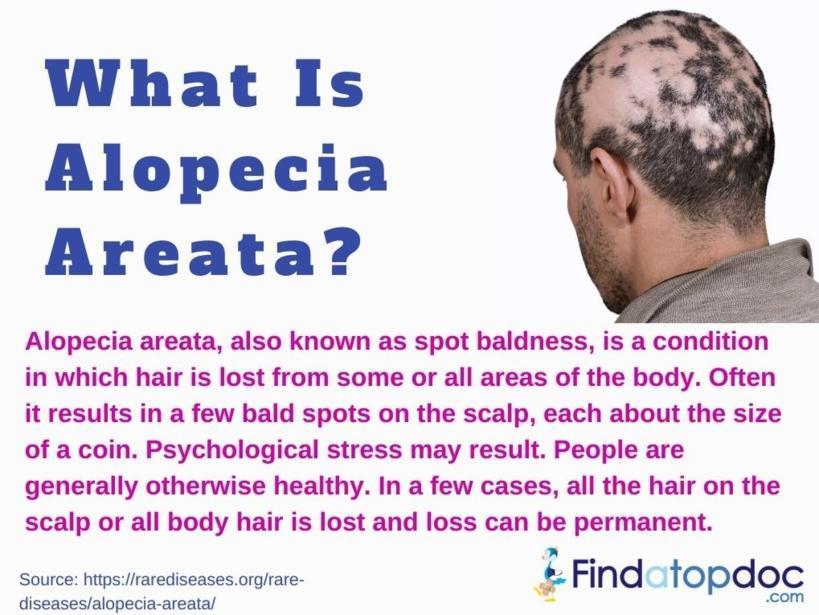
Alopecia areata is a type of hair loss that occurs when your immune system mistakenly attacks hair follicles, which is where hair growth begins. The damage to the follicle is usually not permanent. Experts do not know why the immune system attacks the follicles. Alopecia areata is most common in people younger than 20, but children and adults of any age may be affected. Women and men are affected equally.
What happens in alopecia areata?
Alopecia areata usually begins when clumps of hair fall out, resulting in totally smooth, round hairless patches on the scalp or other areas of the body. In some cases the hair may become thinner without noticeable patches of baldness, or it may grow and break off, leaving short stubs (called "exclamation point" hair). In rare cases, complete loss of scalp hair and body hair occurs. The hair loss often comes and goes-hair will grow back over several months in one area but will fall out in another area.
When alopecia areata results in patches of hair loss, the hair usually grows back in a few months. Although the new hair is usually the same color and texture as the rest of the hair, it sometimes is fine and white.
About 10% of people with this condition may never regrow hair. Because hair is an important part of appearance, hair loss can result in feeling unattractive.In some people with alopecia areata, the fingernails and toenails become pitted-they look as if a pin had made many tiny dents in them. They may also look like sandpaper.Alopecia areata cannot be "cured" but it can be treated. Most people who have one episode will have more episodes of hair loss.
Diagnosis
Alopecia areata is diagnosed through a medical history and physical examination. Your doctor will ask you questions about your hair loss, look at the pattern of your hair loss, and examine your scalp. And he or she may tug gently on a few hairs or pull some out.
If the reason for your hair loss is not clear, your doctor may do tests to check for a disease that could be causing your hair loss. Tests include:
- Hair analysis. Your doctor will take a sample of your hair and examine it under a microscope. A scalp sample is also sometimes taken.
- Blood tests, including testing for a specific condition, such as an overactive or underactive thyroid gland (hyperthyroidism or hypothyroidism).
Treatment
Because hair usually grows back within a year, you may decide not to treat alopecia areata.If you choose not to treat the condition and wait for your hair to grow back, you may wish to:
- Wear hairpieces. Hairpieces are made from human or synthetic hair that is implanted into a nylon netting. Hairpieces may be attached to the scalp with glue, metal clips, or tape. But hair weaving, which involves sewing or braiding pieces of longer hair into existing hair, is not recommended because it may cause permanent hair loss.
- Use certain hair care products and styling techniques. Hair care products or perms may make hair appear thicker. Dyes may be used to color the scalp. But continual use of perms or dyes may result in more hair loss.
Alopecia areata does not affect you as another condition might: it is not painful, it does not make you feel sick, and it does not result in serious health problems. You cannot spread it to other people, and it should not interfere with school, work, or recreation. But if hair loss is making you feel unattractive, it is important to talk to someone about it. A counselor can help, as can talking to other people with the same condition.


